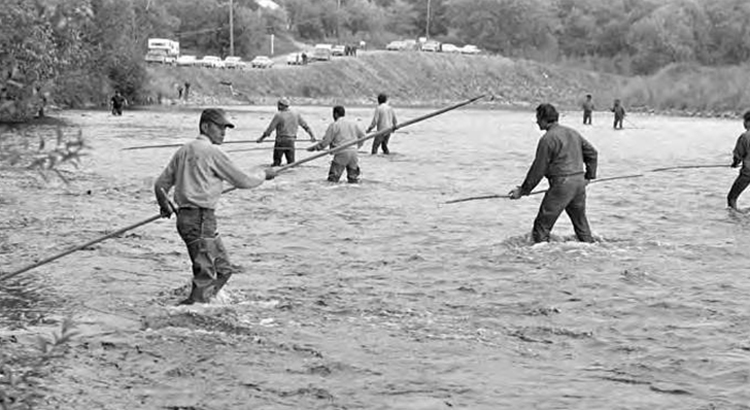Tribes, treaties and justice: Impact of 1974 Boldt Decision echoes today

In a peaceful demonstration, Muckleshoot Tribe members practice their fishing rights in October 1970 in the Green River. At the time, Washington state law restricted Native fishing in spite of treaties that guaranteed tribal members the right to fish.
In 1945, 14-year-old Billy Frank Jr. was arrested for fishing. A member of the Nisqually tribe, Frank was charged with poaching even though it was at a site his family and ancestors had fished for centuries. Furthermore, the 1854 Treaty of Medicine Creek guaranteed him and other Indigenous people the right to fish “at all usual and accustomed grounds and stations.”
But state officials and commercial and sport-fishing interests had been working for decades to curtail Indian fishing. Local police officers and game wardens confiscated catches and gear, arrested Native fishermen and sometimes resorted to violence, firing guns at their boats and assaulting them and their families.
By 1974, Frank was a Korean War veteran and a well-known Indian rights and environmental activist. He practiced his civil disobedience in a boat with a fishing net. That was also the year of the landmark federal case known as the Boldt Decision—in which the federal government and 20 tribes sued the state of Washington to protect Native peoples’ rights to fish and won. The case later shaped the national understanding of Indian rights and tribal sovereignty.
In the decades leading up to the decision, Native American communities in Washington state had struggled to exercise their fishing rights. But in the late 1960s, their issue became part of the Civil Rights movement and drew supporters from around the country to the cause. The heart of the activism was at Frank’s Landing, a site on the Puyallup River between Tacoma and Olympia where generations of the Frank family have lived that also served as a gathering place for tribal fishermen.
“It wasn’t just about fish,” says Richard White, ’72, who joined the protests at Frank’s Landing in the summer of 1968 and whose experience there led him to become a historian of the American West. “It was about shellfish, it was about other things.” White witnessed the chaos and police raids as well as peaceful acts of civil disobedience: tribal members simply putting their boats in the water and fishing. He saw the emergence of new Indigenous leaders like Hank Adams leave their studies at the UW and become activists.
At the time of the fishing-rights case, Native fishermen were taking only about 5% of the harvest, with the commercial fishers taking 90%, according to Charles Wilkinson, an expert in Indian law and author of “Treaty Justice: The Northwest Tribes, the Boldt Decision, and the Recognition of Fishing Rights,” which the UW Press published in January. Wilkinson’s history—written at the request of Billy Frank Jr., who died in 2014—tells the broad saga of Indian fishing rights in Washington, highlighting significant events and individuals—like lawyer Jack Tanner, ’55, the president of the NAACP’s Washington chapter. He was hired by the tribes to fight their case in court. And another, anthropologist Barbara Lane, ’53, who provided expert testimony at the trial about the culture and history of the tribes, the circumstances around the Medicine Creek treaty and contemporary tribal lives and values. Wilkinson describes Lane as “the most important witness in the trial.”
In his U.S. District Court decision, Judge George Boldt affirmed the tribal members’ rights to fish and guaranteed them 50% of the harvest through their traditional fishing grounds and as co-managers of the state’s fisheries. One outcome of the decision is tribal governments’ increased role in protecting salmon and steelhead populations and their habitat here in Washington.
“This and other seminal cases from the Northwest became precedent for cases across the country,” says Ned Blackhawk, ’99, a member of the Te-Moak Tribe of Western Shoshone and scholar of Native American history. “The Boldt decision was among the most important exertions of Native American treaty rights in American history. It was tremendously generative and controversial.” What unfolded in Washington set precedent and encouraged tribes across North America to affirm their own sovereign and treaty rights, he adds.
To honor Frank, the Washington Legislature voted to install a statue of him in the National Statuary Hall in Washington, D.C. “There’s going to be a lot of attention this year as Washington turns the story of the Boldt decision into a kind of celebration,” White says. “The story starts with the struggle and ends with Billy Frank Jr. in the U.S. Capitol.” What shouldn’t be forgotten, he adds, is that state and national leaders “spent years trying to cut off funding to the Indian fisheries community and sought to strip the tribes of power.”
The 9-foot-high bronze statue of Billy Frank Jr. by sculptor Haiying Wu, ’96, is scheduled to be unveiled in 2025.